- News
- December 26, 2021
San Francisco Chronicle Article on New Directions for the David Rumsey Map Center
"At Stanford’s David Rumsey Map Center, the past, present and future converge"
Andres Picon, San Francisco Chronicle
Dec. 24, 2021
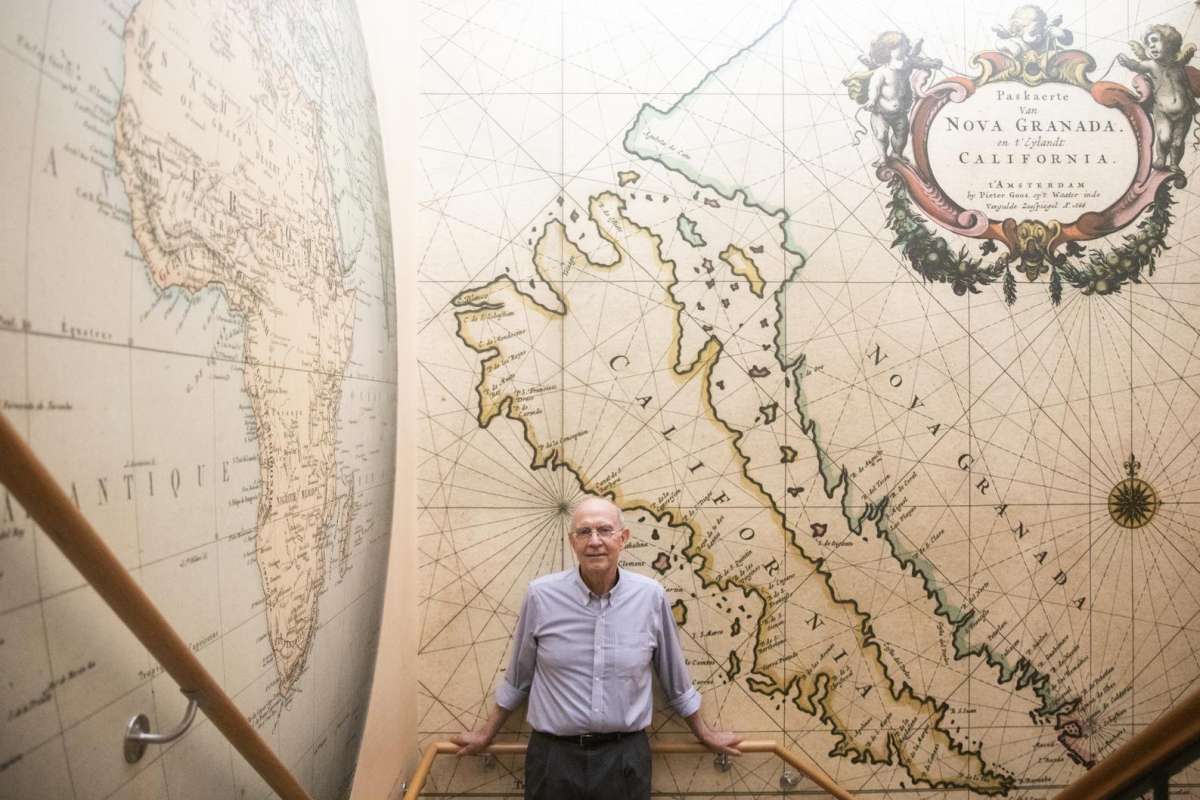 |
|
Map collector and authority David Rumsey with wallpaper made from one of his most treasured maps.
Photos by Jessica Christian / The Chronicle |
Deep inside Stanford University's Green Library, David Rumsey makes his way up a winding staircase, stopping at every turn to admire the various historical map wallpapers that stretch from floor to ceiling. With infectious excitement, he takes in the Paraná River in South America, Hell's Kitchen in Manhattan, Mount Kailash in Tibet and even the constellations, depicted colorfully in a massive celestial chart.
At the top of the stairs, Rumsey, a San Francisco resident and one of the country's leading map collectors, reaches the David Rumsey Map Center, where he again stops to admire a historical map — this time a 1602 goat-hide map of Europe splayed out on a table. He traces the worn, blackened edges with his fingertip.
"It's banged up, but it's beautiful," he said. "It tells a story."
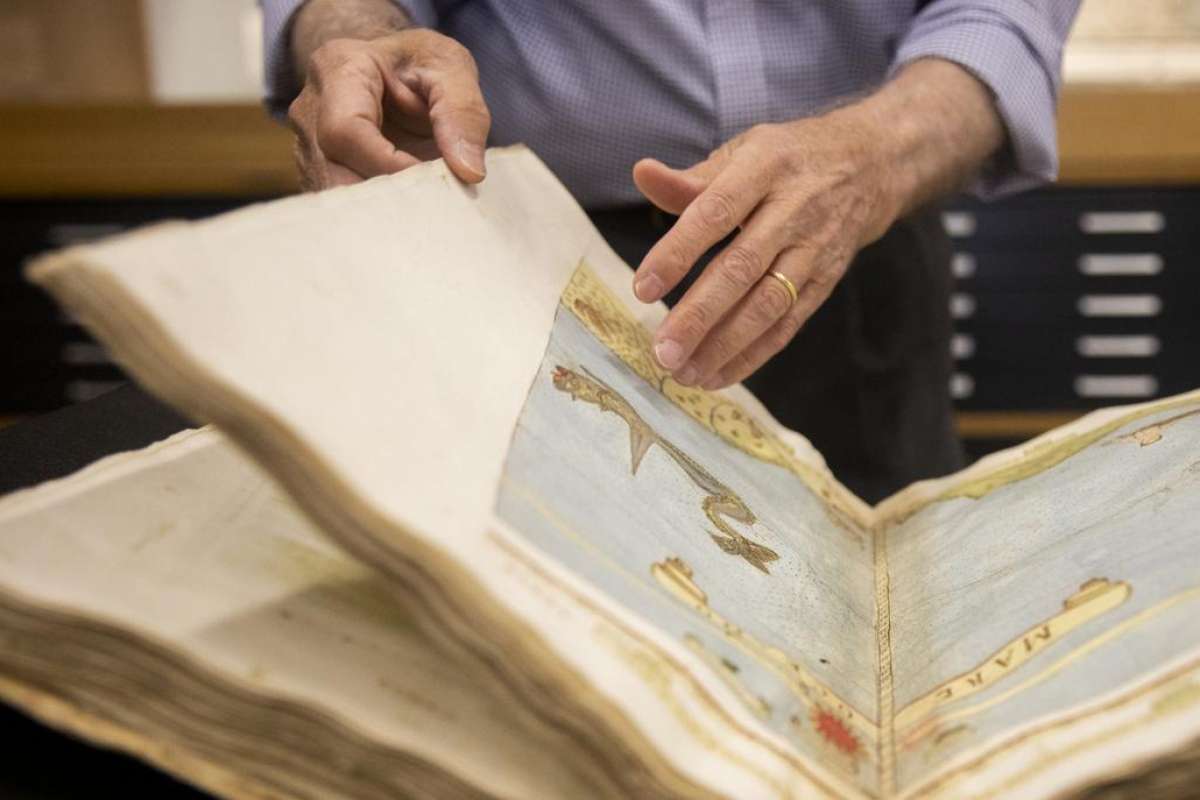 |
|
Rumsey examines the collection’s oldest map, the Multi-Sheet Urbano Monte World Map, 1587, at the map center that bears his name.
Jessica Christian / The Chronicle |
The map center, home to an estimated 250,000 physical maps and more than 200,000 digital maps from 1500 to the present — most of them donated by Rumsey — is a cross between a library and a laboratory, replete with leatherbound atlases, spinning globes, enormous high-definition touchscreens and several virtual reality stations.
"I call this ‘map heaven,'" said G. Salim Mohammed, the center's head and curator. "This is a place where maps come alive." It's a cozy space where the past, present and future converge to accomplish what Rumsey has been working toward for more than two decades: making historical maps, and the information they hold, accessible to the public, not just experts and collectors.
 |
|
Map collector David Rumsey stands at the base of a wall decorated with a Celestial Atlas Plate 2: Cetus, Aquarius, Andromeda, 1693 by Ignace-Gaston Pardies at the David Rumsey Map Center inside the Cecil H. Green Library at Stanford University . Rumsey has donated much of his historical map collection to the Center.
Jessica Christian/The Chronicle |
"You can have hundreds of thousands of maps, but if you can't discover them, they don't exist," Mohammed said. "That is where this library comes in."
The idea is for the center to serve as an arena for experimentation and education where individuals, regardless of their scholarship on maps, can explore the primary documents and their scanned, digital counterparts in order to perhaps learn a little bit about where we've come from and where we are today.
At the heart of that endeavor is the digitization of Rumsey's vast physical collection, a project he began in the late 1990s when he launched davidrumsey.com, a constantly growing aggregation of about 112,000 digitized historical maps from his personal inventory. Rumsey, 77, is in the process of donating his entire map collection — more than 200,000 physical maps plus the digital ones — to Stanford so that they can be cataloged for the enjoyment of generations to come.
"It's not only a database; it allows people to get lost inside it, no pun intended," he said. "If you make it really usable and accessible the way ours is, it just becomes something different."
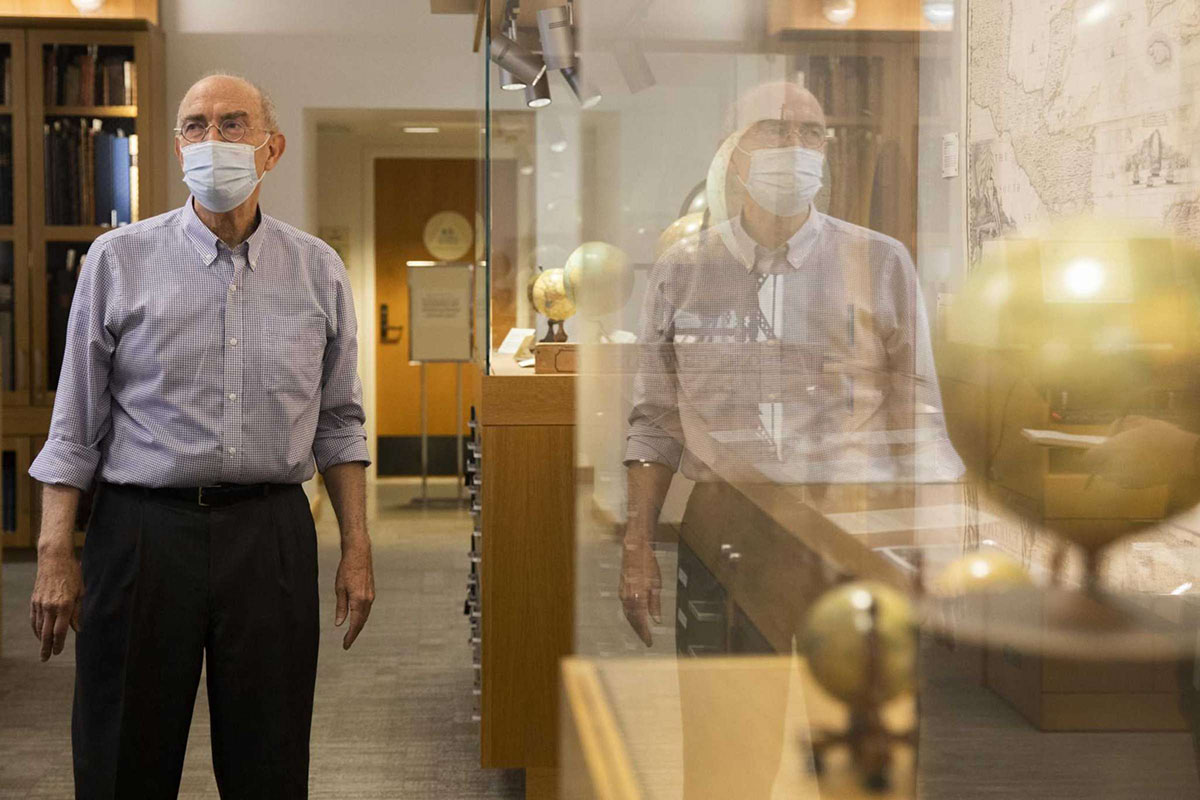 |
|
Map collector David Rumsey stands among glass cases of priceless globes he donated to the David Rumsey Map Center inside the Cecil H. Green Library at Stanford University in Stanford, Calif. Monday, Dec. 6, 2021. Rumsey has donated much of his 150,000 historical map collection to the Center.
Jessica Christian / The Chronicle |
The map center, which opened in 2016, has been called the "gold standard" of map libraries and is at the forefront of some of the most advanced mapexploration technology. Visitors are able to experiment with georeferencing, 2-D and 3-D map overlays, and virtual and augmented reality equipment — much of that made possible in part by Stanford's high-resolution scanners that produce stunning digital maps with up to 800 pixels per inch.
Georeferencing allows a user to digitally place a historical map on top of a modern map. The user can change the transparency of the old map to see the modern map underneath, revealing changes over time and combining unique aspects of each map.
Rumsey recently demonstrated the tool with an 1857 map of San Francisco over the modern Google Maps version. He dialed up the old map's transparency to show how certain parts of the city today, such as Rincon Hill and Mission Bay, were once part of San Francisco Bay.
The center's staff have also turned historical and modern maps into 3D landscapes accessible through virtual reality. The street layout of Paris in the 18th century could suddenly be explored using a map from that time and an Oculus Rift headset.
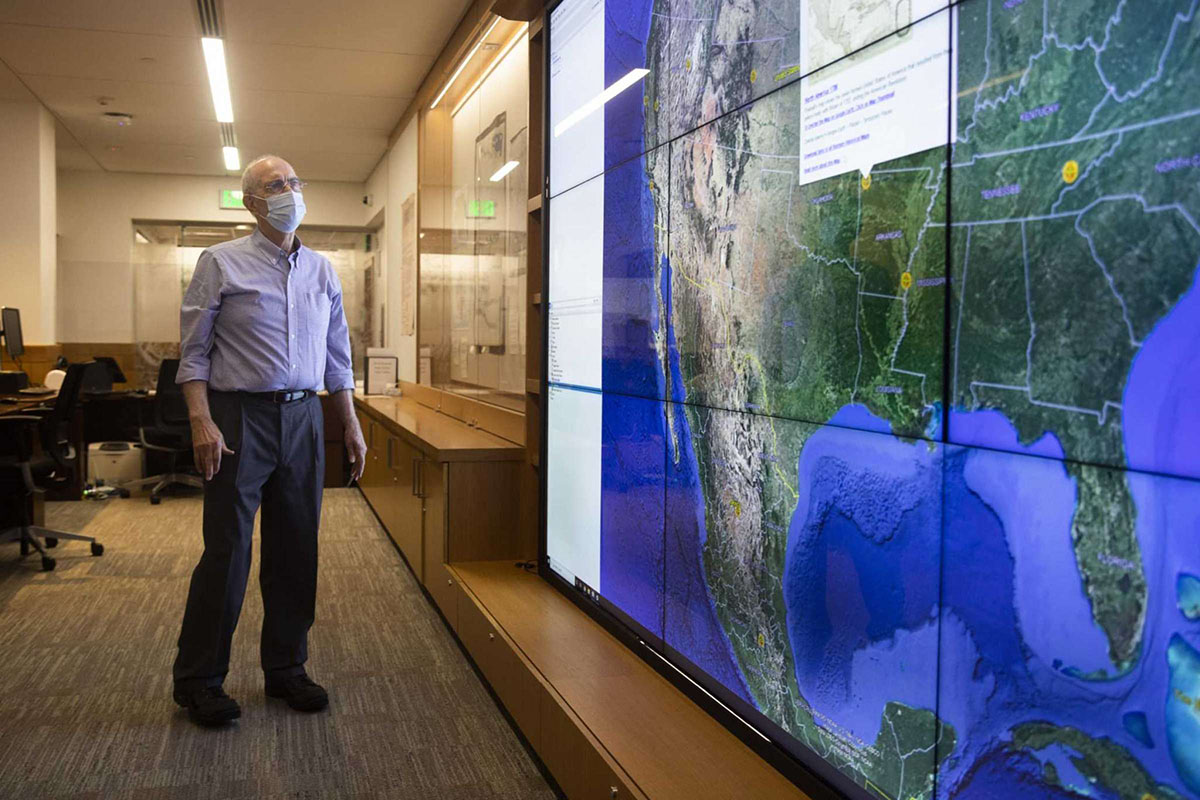 |
|
Map collector David Rumsey stands against a touch screen catalog of the full collection at the David Rumsey Map Center at Stanford University.
Jessica Christian/The Chronicle |
A Stanford professor once took her class to the map center for a lesson on empathy in which students were able to "visit" a Syrian refugee camp using the same technology.
"There wasn't a dry eye that day," Mohammed said. "It's about putting the students in that space."
Those kinds of experiments are at the crux of the map center's mission. Maps are representations of our past and present, each made unique by the motives and experiences of their creators, Rumsey and Mohammed said. By expanding opportunities for immersion in and exploration of those representations, visitors can gain insight into history as well as valuable context for the present.
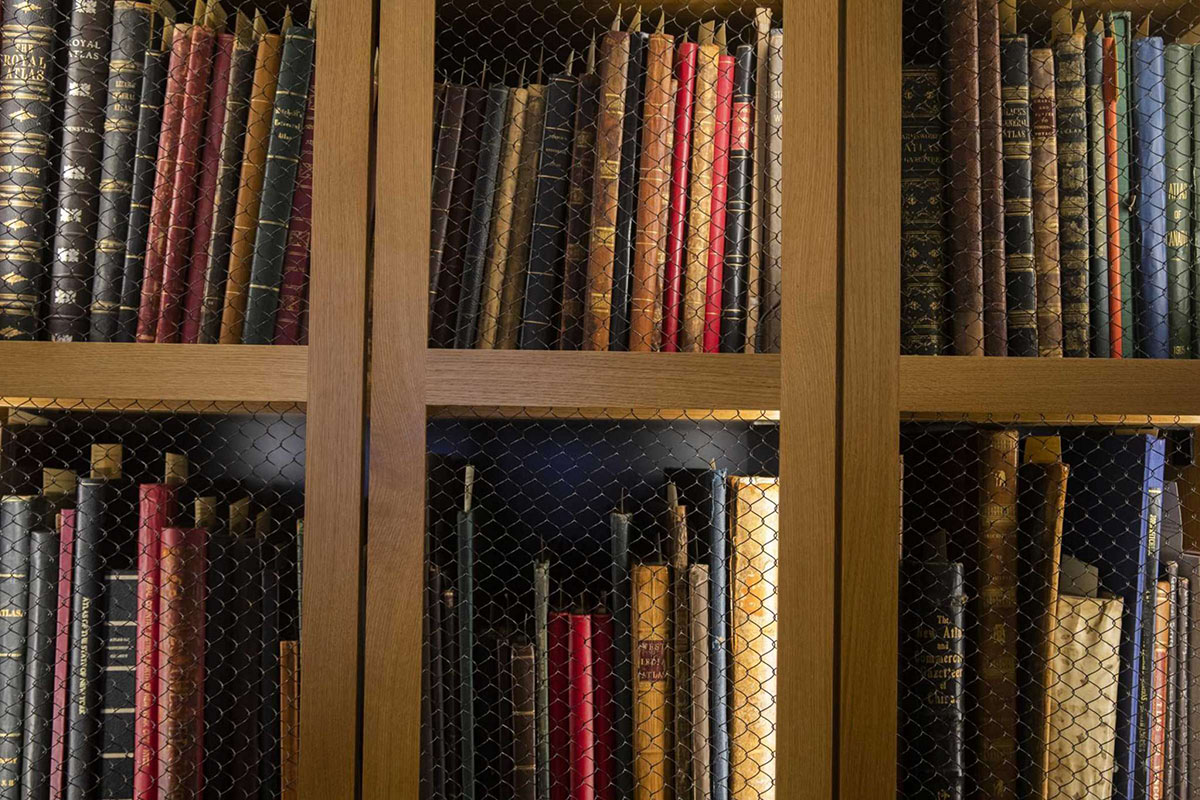 |
|
Atlases donated by map collector David Rumsey sit behind locked shelves at the David Rumsey Map Center at Stanford University.
Jessica Christian/The Chronicle |
"The beauty of the old maps is the way they were drawn, the artistry involved," Rumsey said. "But from an informational perspective, they're history. Everything happens somewhere, so they are ways of seeing history."
Throughout the next few years, the center will continue to advance the technology it makes available to visitors, Rumsey and Mohammed said. They hope to incorporate artificial intelligence to make it possible to search for words on digitized maps regardless of their orientation or position, as well as a framework for systematically searching digital map files across platforms and databases. They're also looking to put greater emphasis on data visualization and to expand into the metaverse, which could "pull users into the map world," Rumsey said.
"It's way more than just the individual maps; it's about the use of the maps," Rumsey said. "We try to push the boundaries."
The map center also hosts events, lectures and exhibitions, such as one currently on display about indigenous mapping. The center is open only to Stanford students and employees due to COVID-19 restrictions, but the staff hopes to be able to reopen it to the public by next summer.
Andy Picon is a San Francisco Chronicle staff writer.
Email: andy.picon@hearst.com Twitter: @andpicon
11 Comments on San Francisco Chronicle Article on New Directions for the David Rumsey Map Center
Ein sehr schöner Einblick in diese Sammlung. Gibt es dazu auch einen digitalen Zugang? Beste Grüße aus Deutschland
Ich kann mich dem Kommentar von Donna nur anschließen. Vielen Dank an David Rumsay!
I am deeply indebted to Mr. Rumsey and Stanford for creating and sharing this amazing resource. I have made many amazing discoveries of places where my ancestors once lived, but that have since been lost or forgotten on modern maps. Keep up the great work!
I have a map by Chriftoporus Saxon 1578 if you may be interested my email: xix000@aol.com Mobile no 07887406767 Mr Francis Montgomery Craig.
Thanks for making these available to my, a genealogist of over 30 years, where I can find those old places that don't exist any longer. Thank you!!!
Your maps have helped me find shtetls destroyed during the Shoah. Thank you for your work and your generosity. Generations will remember you. Jennifer
Some years ago I found that many of the maps created by one of my family are in this collection. We all know we have ancestors but it's always more interesting when we can essentially put "flesh on their bones" and see what they created when they were living.
Fifteen or so years ago, David showed me his many many maps of the Mississippi River, and gave me a general tour of his collection. A remarkable and generous person. I am glad to see his collection will continue to be available to scholars. Thank you David and Stanford U.
Amazing! Simply amazing! Thank you, David. Your passion, generosity, and kindness shines through.
I inherited my love of history and maps from my late Father who was a Pathfinder in the U.S. Army and also a history buff. Years ago, when I first discovered David Rumsey's website and his collection of historical maps, I was amazed. Thanks David for all your work to allow average people to access your wonderful map collection. I look forward one day to visit the Rumsey Map Center at Stanford and be amazed once again.
We all owe David Rumsey mountains of thanks for all he has done to make Genealogyand Family Stories come alive!